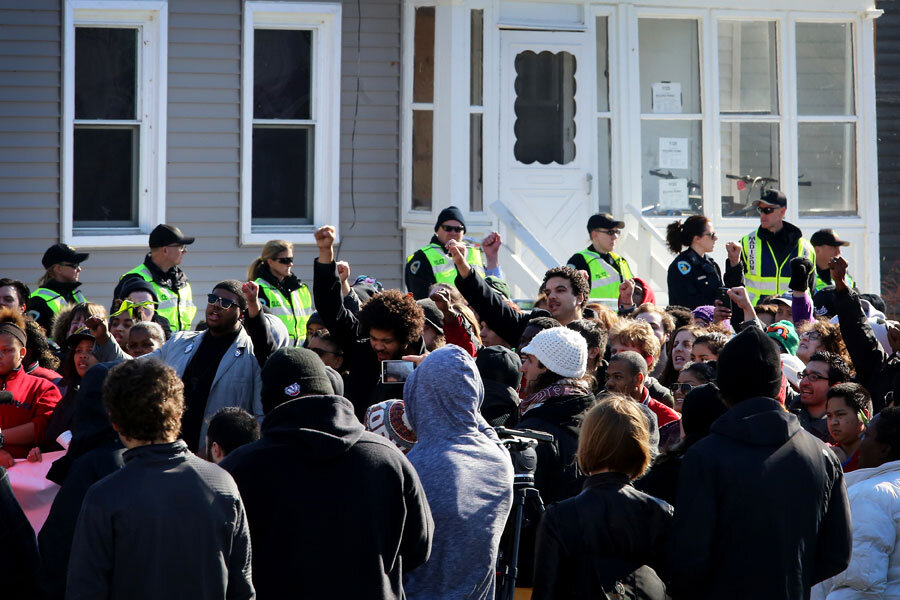In Madison police shooting and beyond, Ferguson casts long shadow
Loading...
A month after Ferguson, Mo., had erupted into violent street riots, the police chiefs of some of North America's biggest cities gathered in Chicago.
Ferguson, they said, was a watershed moment in policing. The days of hiding behind a blue wall of silence were gone. The police chiefs – from Dallas to Chicago to Boston to Toronto – agreed: A new era of transparency was upon them, and they needed to be ready for it.
The news that another fatal shooting of an unarmed black teen – this time in Madison, Wis. – has been met with protests and national headlines is further evidence that they may well have been right.
Since Ferguson police officer Darren Wilson shot and killed Michael Brown on Aug. 9, calls for police reform have come from a President Obama-convened task force on down. But they have also come in protests from Cleveland to Albuquerque and Los Angeles to Madison. Protesters in Madison Saturday chanted "Black Lives Matter" – the mantra of Ferguson protesters – and the Madison police chief has had to appeal for calm. So far, the crowds of dozens of protesters have complied.
Six months to the day after Mr. Brown died, the ongoing attention to police shootings – particularly of unarmed suspects – speaks to the imprint Ferguson has left.
It is true that police killings hit their highest level in two decades in 2013, the most recent year for which data were available, according to a USA Today analysis of Federal Bureau of Investigations figures. But the new unrest appears to be driven more by other factors.
Civil rights groups have seized on police violence against young black men as a new frontier in racial equality. Speaking at the 50th anniversary of the "Bloody Sunday" march in Selma, Ala., Sunday, Mr. Obama cited a federal report showing racial bias in the Ferguson Police Department in saying that "that this nation’s racial history still casts its long shadow upon us."
Moreover, a stream of videos circulated on social media and 24-hour news networks feeds the narrative, showing deadly police encounters through an unvarnished lens. Just last week, a fatal police shooting of an unarmed homeless man in Los Angeles was caught on video, leading to questions about the officers' use of deadly force.
Add to that a decades-long decline in crime in the US, and many Americans appear more ready to question police tactics.
"I think there's been a broad public shift just based on the fact that crime has decreased," said Vikrant Reddy, an analyst with the conservative policy group Right on Crime, to NPR.
Whether the continuing public pressure will have an effect on how police departments or district attorneys handle police shootings is an open question. But there are few doubts that police are feeling it.
"A lot of officers I've heard – not just in Baltimore but nationally when I talk to other mayors – said they want to make sure that they get it right," said Baltimore Mayor Stephanie Rawlings-Blake in December. "It's understandable if they feel at greater risk. We are, for our generation, for many of those who are active on the street, in uncharted territory. There is a lot of unease."
"They don't want to be the next Darren Wilson," she said.
That media glare has now shifted to Madison, where police say white police officer Matt Kenny fatally shot unarmed black teen Tony Robinson this Friday. Mr. Robinson, 19, had run-ins with the law before. He was serving three years probation after pleading guilty in October to armed robbery. But Mr. Kenny, too, had been involved with a previous fatal shooting, killing a man eight years ago who Police Chief Mike Koval said was committing "suicide by cop."
In the current case, officer Kenny was called to investigate Robinson, who was behaving erratically in public. Kenny followed Robinson to his apartment and then forced entry when he heard a disturbance inside, Mr. Koval said. Kenny shot Robinson in the altercation that followed, Koval added.
Wisconsin Attorney General Brad Schimel promised a thorough and transparent investigation; further protests are already planned for Wednesday.
Some suggest that there is a double standard to the media coverage, noting that when a black cop fatally shot a 20-year-old unarmed white man in Utah last August, few national news outlets took note.
But the spotlight being shed on police killings has already led to stirrings for reform. New York and California have discussed bills to take cases of police killings out of the hands of grand juries that can be influenced by local prosecutors beholden to local cops. FBI Director James Comey has backed congressional legislation calling for better reporting of police-involved shootings.
For their part, the chiefs from the Police Executive Research Forum, who met in Chicago last September, pledged greater transparency. Ferguson, they said, had to lead to a new form of policing – one that emphasized deescalation, according to a Reuters report.
By all appearances, they will be held to their word.








